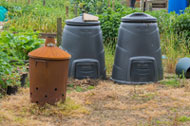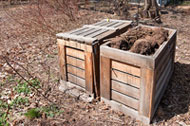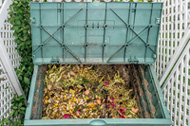Compost at home
Why Compost?

Composting can improve the environment. Our modern lifestyles involve a very high rate of consumption of goods which are heavily packaged. Over 1 million tonnes of waste are generated in Northern Ireland each year; this equates to 1.75 tonnes per person. Materials suitable for composting account for up to half of household waste - by composting these we would reduce reliance on landfilling of waste and nutrients would be recycled back into the soil. Compost can: help your garden/potted plants; increase yields of fruit, vegetables, flowers and herbs; reduce reliance on the use of toxic chemicals and pesticides; make an ideal soil conditioner and surface mulch; provide a free soil conditioner; help soil to retain moisture, reducing water consumption.
Composting is a natural process which converts organic waste into an earth like mass by means of bacteria and micro-organisms. The composting process is supported by larvae, wood lice, beetles, worms and other such creatures. Moisture and oxygen are the other important factors in the composting process. Heat is generated during the composting process. As a result, the temperature in the composter may rise to about 50 degrees celsius. Micro-organisms flourish at this temperature, enabling the composting process to proceed more rapidly. The aim of the following section is to provide householders with simple guidelines around how to compost easily and successfully.
Which Container to Use?
The container you use will depend on the size of your household and the amount of compostable material being produced.




Plastic Compost Bins:
Most householders use the standard compost bins available at garden centres and some recycling centres. These bins have a capacity of about 300 litres. Alternatively, home made compost bins can be constucted from old wood such as old pallets.
Home-made Compost Bin:
Some households are opting for home-made compost bins. They have been successfully made from pallets, wood, bricks, blocks, etc. These bins often have a removable front panel and will need a cover to protect the heap from heavy rain (canvas-backed carpet is often used). If you have a large garden with plenty of grass clippings, you are probably better off having a separate pile of grass and shredded paper/cardboard layers - cover from heavy rain is necessary.
Wormeries:
This method uses worms to carry out the decomposition and does not heat up during the process. A wormery is a fully enclosed container which is populated by Tiger Worms (earth worms not suitable - soil content too rich), and come in a variety of shapes and sizes. They are very popular with children but need a lot of care just as a pet would! Small quantities of cooked food can be put into your wormery - 1kg of worms can produce ½ kg of compost. Add about 1.5kg of food the first week - this can be gradually increased to about 7kg over a period of six months. Wormeries produce an excellent quality compost material and also a liquid feed called “worm tea”!
Leaf Mould:
Wire mesh and wooden stakes are very suitable for leaf mould. As leaf mould doesn’t require sunlight, the leaves can be placed in black plastic bags/fertiliser bags pierced with a fork for air. Leaf mould takes about two years to produce compost and as it is low in nutrients, it makes excellent potting compost. It can also be used very effectively as a mulch to keep down weeds and retain moisture.
Starting to Compost:
- Where to position your container once you have decided on your composter: The next step is to find somewhere suitable to position it. Easy access for filling and turning purposes is important. It is best positioned where it can get some sunlight but not direct sunlight for the whole day. The bin needs to be placed in a sheltered spot protecting it from heavy winds and will need to be covered in heavy rain to avoid water logging.
- Filling your bin: Making compost is a bit like making a cake - if you follow the list below your will have selected the right ingredients. Organic Waste is often divided into Green (nitrogen) and Brown (carbon) categories depending on its chemical make-up. As a rule of thumb, roughly equal amounts of each type of waste should be used. Most households find it difficult to gather enough Brown waste for composting. A tip here is to gather a few sacks of autumn leaves for addition to your heap during the year. Shredded paper and torn, damp cardboard is also ideal. When starting a compost heap, first place a layer of the Brown material in your container. Straw, shredded twigs, paper or autumn leaves are ideal for this. Once this first layer has been placed in the container, Green and Brown material should be added in equal amounts. It is important to aerate the bin and so regular turning of the contents with a fork is necessary. This will speed up the decomposition process. Another way to do this is to chop and shred materials for the bin if possible.
- When will the compost be ready? When the compost is ready there should be hardly any traces of the original materials used. It should be dark, crumbly and sweet smelling. Home produced compost will not be as fine as bagged compost available from a garden centre. The production time of your compost will depend on the following: your mix of Green and Brown; if it has been shredded; if it has the right amount of moisture and air content; if it has been turned or loosened regularly.
See Belfast City Council's information on composting at home and the Rethink Waste site for information on community composting.

